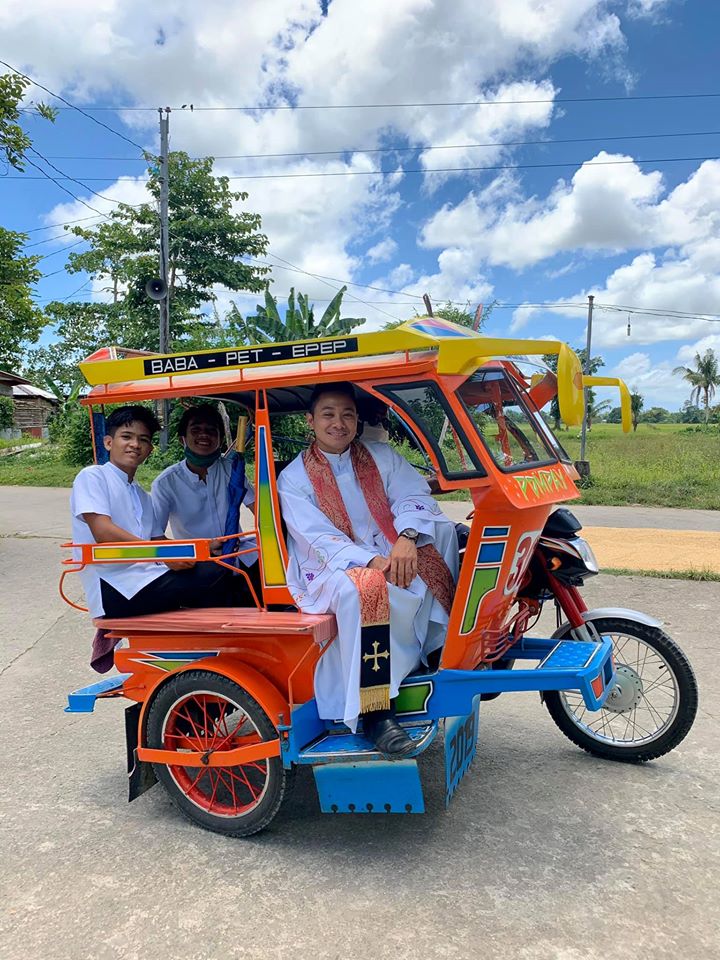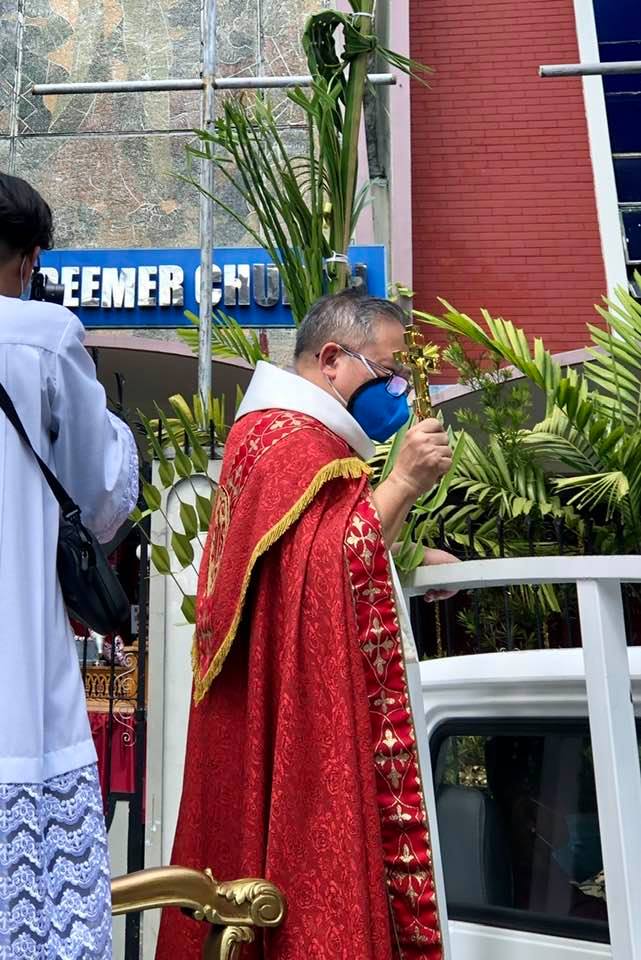By Rommel F. Lopez

Fr. Mark Ivo Velasquez of the Archdiocese of Palo riding the tricycle with some of his altar boys to bless the palms of his parishioners in Alangalang, Leyte (photo from Fr. Ivo’s Facebook account)
It should have been the usual Holy Week he has celebrated since getting ordained to the Catholic priesthood 12 years ago.
But for Fr. Mark Ivo Velasquez of the Archdiocese of Palo, a survivor of Supertyphoon Yolanda, this is a Holy Week like no other.
He had to take a tricycle to visit some of the 20 chapels in his “mission station” in Alangalang, Leyte, composed of 14 barangays.
A conversation with his tricycle driver made him realize that this was no ordinary season.
“My trike driver was telling me this afternoon as we toured the barrios that this was worse than Yolanda. And I agree with him because we still got to celebrate these feasts as they were. We didn’t have Christmas this 2019 because of [Typhoon] Ursula and now we won’t have a nice Holy Week because of COVID-19,” he said.
It is indeed an extraordinary time for 85% of the Philippines’ 104.9 million Filipinos who identify as Roman Catholics to observe traditional practices during the holiest of days in the Church’s liturgical calendar, with the whole world fighting this pandemic.
Priests like Fr. Velasquez had to find more creative ways to minister to their people especially after both civil and church authorities prohibited public gatherings to lessen the spread of Covid-19.

Fr. Michelle Joe Zerrudo of the Most Holy Redeemer Parish Church – Araneta under the Diocese of Cubao blessing the palm fronds of his parishioners at the back of a pick up truck.
The Catholic Bishops’ Conference of the Philippines released guidelines for bishops and priests in the country on how to celebrate the liturgies of Holy Week as the country deals with the outbreak.
On our Previous Suggestion (cf. CBCP Circular 20-15): For the presider of the celebrations to go around the parish after every celebration whether to bless the Palms, bring the Blessed Sacrament and the Cross:
This should be considered with great caution, having in mind not to give an opportunity for our faithful to congregate outside their homes. In such a scenario, it will be very difficult to implement the “social distancing” measure. Moreover, such a scenario will be in contradiction to the lock down and “stay at home” measures now enforced in many places.
On this matter, close coordination with local government and health authorities should be done.
A Filipino Catholic’s Palm Sunday tradition would not be complete without bringing home a blessed palm frond. Aware of this, Roman Catholic bishops and priests sought better ways of reaching out to their flock during these sacred days in the Church’s calendar while sticking to the government’s mandate of maintaining a safe distance from each other to prevent the possible transmission of the deadly virus.
In the Diocese of Kidapawan, Bishop Jose Colin Bagaforo permitted all priests to bless palm fronds in designated streets and areas with the help of Extraordinary Ministers of Holy Communion, commonly known as lay ministers, in far-flung village chapels.
In the Most Holy Redeemer Parish Church in the Diocese of Cubao, Parish Priest Fr. Michel Joe B. Zerrudo, riding on the back of a slowly moving pick-up truck, blessed palm fronds held by his parishioners who were standing in front of their houses mindful of the social distancing policies implemented by the government.
Former CBCP president Archbishop Socrates Villegas of Lingayen-Dagupan also stood at the back of a pick-up vehicle to bless palm fronds waved by Catholics around the streets of Dagupan City.
“Jesus rode on the back of a donkey. I rode on the back of a pick-up truck,” Fr. Zerrudo joked.
Fr. Velasquez, for his part, went around the territorial jurisdiction of his mission station, blessing the palms of his flock save for one chapel, which was too far.
People he could not reach went out to meet him and brought their palms to the nearest chapel.
Fr. Velasquez said that “the measures that the Church had adopted to enable the faithful to enter into the spirit of this sacred time has allowed us to go where people usually are: in their homes and boroughs.”
“In many of these places where I have been today, the faithful had wanted that I go to their homes; for them it was a privileged moment, for through sacred signs and actions, the Lord was with them, and they rejoiced in the sign of his continuing presence,” he said.
For devout Filipino Roman Catholics, this is the first Holy Week they will be observing the rituals from the safety rather than comfort of their own homes.
Jan Pascual, a camarero or an individual who owns or prepares religious images for procession, said this year’s Holy Week would be “a very unexpected, unusual, yet a more meaningful way.”
“For the past 5 years, I was very busy during Holy Week, preparing the carroza of our santa, Santa Maria Jacobe, for our town’s (Santa Rita, Pampanga) Holy Week procession,” he said.
He said prepping the saint’s image and carroza (processional carriage) had caused him to miss out on the important liturgical activities like the Mass of the Lord’s Supper on Holy Thursday and the Liturgy of the Passion of our Lord on Good Friday.
But because of the Luzon-wide enhanced community quarantine that led to the cancellation of religious processions, he would be able to “attend” the liturgies, albeit online.
Professional photographer and College of St. Benilde instructor Jay Mangussad, meanwhile, said he and his family would have their stations of the cross at home with images of each station flashed on their TV screen. The readings are on their phones or printed on paper.
“It would be our first stations of the cross where we stand still and kneel without walking around,” he said.
Fr. Zerrudo, for his part, believes that this extended quarantine is giving Catholics the “opportunity of time and solitude” during Holy Week.
“In a way, the Holy Week has become the only opportunity for many to go on vacation. And so they readily sacrifice their Holy Week in order to go on vacation. But now the vacation is long to the point that it seems nakakaumay (tiresome) and then there is no place to go. Some people resort to do silly things like TikTok but eventually we tire of superficial entertainment,” he said.
Even if this Holy Week will be devoid of the traditional rituals and spectacle, it will be a “great Holy Week,” he said.
“Yes it will be devoid of the trimmings of rituals but it will definitely be a humbling experience of renewal. In this pandemic, we realize that man truly does not live on bread alone but on every word that comes from God. Less pageantry but more solitude prayer and charity.”
He was hoping the pandemic urges not just Catholics, but all people, to renewal and conversion and “leave the mark of a new heavens and a new earth in a certain degree.”
Pascual agreed. The quarantine made him realize what’s more important in life
“I was acting like St. Martha of Bethany who was troubled by many things. I can hear Jesus telling me the exact words he said to Martha when he visited them at their house in Bethany, “Martha, Martha, you are worried and upset about many things, but few things are needed — or indeed only one. Mary has chosen what is better, and it will not be taken away from her.”
Fr. Velasquez said this extraordinary time would be “one of the best experiences in my life as a priest.”
“Because these are times wherein you’re made to realize that you’re not in charge,” he said.